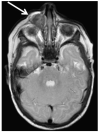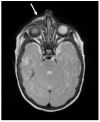The Role of Chemotherapy in Management of Inoperable, Metastatic and/or Recurrent Melanotic Neuroectodermal Tumor of Infancy-Own Experience and Systematic Review
- PMID: 34359769
- PMCID: PMC8345623
- DOI: 10.3390/cancers13153872
The Role of Chemotherapy in Management of Inoperable, Metastatic and/or Recurrent Melanotic Neuroectodermal Tumor of Infancy-Own Experience and Systematic Review
Abstract
Melanotic Neuroectodermal Tumor of Infancy (MNTI) is a very rare pediatric neoplasm of neural crest origin. In most cases, it develops in infants as a localized tumor of the maxilla, and surgery is usually curative. In less than 10% of patients with inoperable, metastatic or persistently recurring MNTI, chemotherapy (CHT) may be considered; however, its role is still unclear. The aim of our study was to assess the efficacy of CHT in children with large, inoperable, metastatic and/or recurrent MNTI. Four such infants, treated with CHT in Polish and German centers of pediatric oncology, were presented. Additionally, a systematic literature search of the PubMed/MEDLINE, Scopus and Web of Science databases was performed, yielding 38 similar cases within the last 42 years. Neoadjuvant CHT, based mainly on the protocols for neuroblastoma, was often effective, allowing for complete delayed surgery in most cases. However, the role of adjuvant CHT in preventing recurrences after incomplete resection of MNTI remains unclear. Disseminated inoperable MNTI was almost universally associated with poor response to CHT and unfavorable outcome. Further investigations to elaborate standards of management in patients with inoperable, metastatic or persistently recurring MNTIs are necessary to improve outcomes.
Keywords: adjuvant; chemotherapy; inoperable; melanotic neuroectodermal tumor of infancy; metastatic; neoadjuvant; recurrent; systemic treatment.
Conflict of interest statement
The authors declare no conflict of interest. The funders had no role in the design of the study; in the collection, analyses, or interpretation of data; in the writing of the manuscript, or in the decision to publish the results.
Figures






References
Publication types
LinkOut - more resources
Full Text Sources

